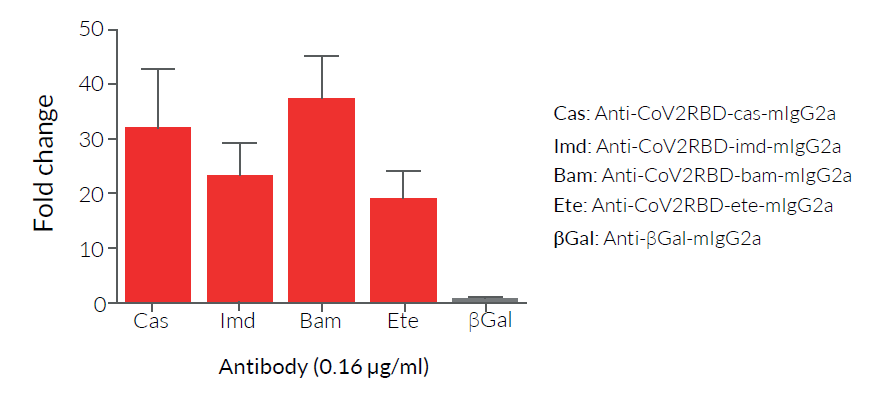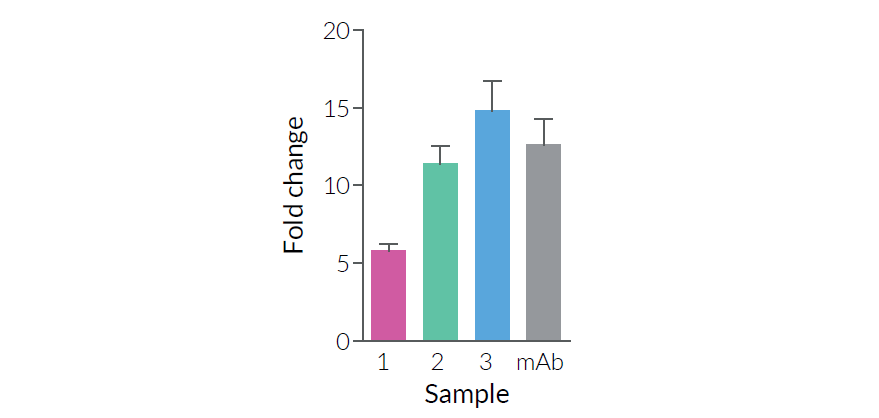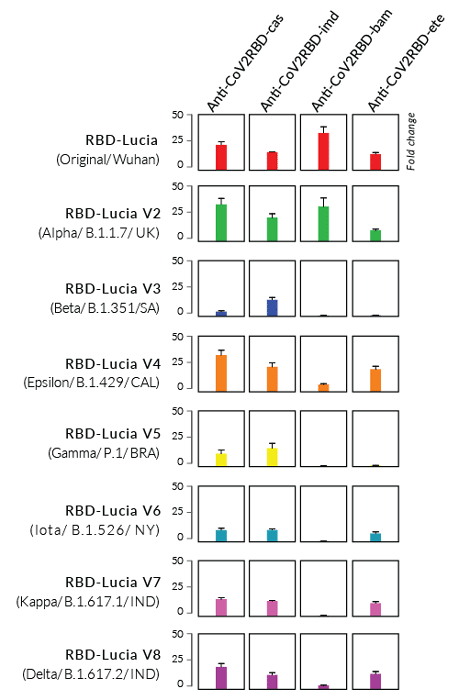Original strain - Luciferase tagged RBD protein
| Product | Unit size | Cat. code | Docs. | Qty. | Price | |
|---|---|---|---|---|---|---|
|
RBD-Lucia Luciferase tagged original RBD protein |
Show product |
50 µg |
rbd-lucia
|
|

Key amino acids in the RBD (original)
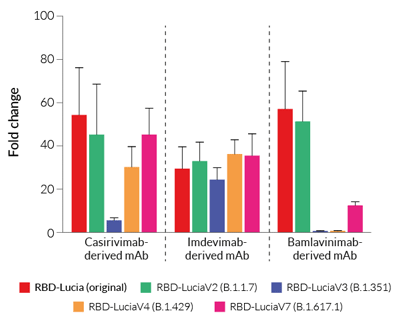
Binding affinity of Anti-Spike mAbs using
Spike variant RBD-Lucia proteins
 InvivoGen also offers:
InvivoGen also offers:
• REGN-10933 & REGN-10987-derived antibodies
• LY-CoV555 & LY-CoV016-derived antibodies
Recombinant RBD fusion protein (Original strain - Wuhan origin) for ELISA & LIPS
RBD-Lucia (~52 kDa) is a soluble fusion protein composed of the Receptor Binding Domain (RBD) from the original SARS-CoV-2 Spike protein fused to a C‑terminal Lucia luciferase tag. RBD-Lucia has been specifically designed to assess the binding affinity of anti-Spike antibodies using either ELISA or LIPS (luciferase immunoprecipitation systems) assays [1-3].
SARS-CoV-2 Spike RBD
RBD-Lucia contains the Spike RBD domain, including the receptor-binding motif (RBM), from the original SARS-CoV-2 isolate first reported in Wuhan in December 2019 [4]. This protein is characterized by the presence of a number of key amino acid residues (below) and is classified as the root of the pandemic in Clade 19A/ Lineage A (Nextstrain/Pango lineage classification).
- K417, L452, S477, T478, E484, and N501
![]() Learn more about the emerging SARS-CoV-2 variants around the world
Learn more about the emerging SARS-CoV-2 variants around the world
Applications
Luciferase-tagged RBD proteins are ideal for studying the binding of anti-spike monoclonal antibodies (mAbs) by solid-phase ELISA as well as anti‑spike polyclonal antibodies in the sera of recovered COVID‑19 patients and/or vaccinees by LIPS [1-3].
- ELISA: the Lucia luciferase tag provides a larger dynamic range than the commonly used HRP detection.
- LIPS: for the detection of antibodies, against both linear and conformational epitopes.
Importantly, using InvivoGen's expanding collection of Spike variant RBD-Lucia proteins, it can be seen that the SARS-CoV-2 variants display varying binding affinities to the different clinically relevant anti-Spike mAbs (see right). RBD‑Lucia has been generated by recombinant DNA technology, produced in CHO cells, and purified by IMAC (Immobilized Metal Affinity Chromatography) using a C‑terminal histidine tag. Protein size and purity (>90%) have been validated by SDS‑PAGE and the absence of endotoxin contamination has been confirmed using cellular assays.
References:
1. Burbelo, P.D. et al. 2010. Antibody-profiling technologies for studying humoral responses to infectious agents. Expert Rev Vaccines 9, 567-578.
2. Haljasmagi, L. et al. 2020. LIPS method for the detection of SARS-CoV-2 antibodies to spike and nucleocapsid proteins. Eur J Immunol 50, 1234-1236.
3. Liang, Y. et al. 2021. A luciferase immunosorbent assay for quantitative detection of IgG antibodies against SARS-CoV-2 nucleoprotein. J Virol Methods 292, 114141.
4. Zhou, P. et al. 2020. A pneumonia outbreak associated with a new coronavirus of probable bat origin. Nature 579, 270-273.
Specifications
RBD-Lucia
- Protein construction: RBD [R319-F541] from the Spike glycoprotein fused to a C-terminal Lucia luciferase reporter
- Accession sequence: YP_009724390 (codon-optimized)
- Origin: SARS-CoV-2 Wuhan-Hu-1 (D614) isolate
- Tag: C-terminal 6x Histidine tag
- Total protein size: 461 amino acids (including the Lucia luciferase)
- Molecular weight: ~52 kDa (SDS-PAGE)
- Purification: Immobilized metal affinity chromatography (IMAC)
- Purity: >90% (SDS-PAGE)
-
Quality control:
- The protein has been validated by ELISA upon incubation with a coated Anti-murine IgG (Fab')2 and a clinically relevant anti-Spike mAb.
- The absence of bacterial contamination (e.g. lipoproteins and endotoxins) has been confirmed using HEK-Blue™ TLR2 and HEK-Blue™ TLR4 cellular assays.
Contents
RBD-Lucia contents:
- 50 μg of lyophilized protein
- 1.5 ml of endotoxin-free water
- 1 tube of QUANTI-Luc™ 4 Reagent, a Lucia luciferase detection reagent (sufficient to prepare 25 ml)
![]() The product is shipped at room temperature.
The product is shipped at room temperature.
![]() Lyophilized protein should be stored at -20°C.
Lyophilized protein should be stored at -20°C.
![]() Resuspended protein is stable for up to 1 month when stored at 4°C, and 1 year when stored at -20°C.
Resuspended protein is stable for up to 1 month when stored at 4°C, and 1 year when stored at -20°C.
Avoid repeated freeze-thaw cycles.
Back to the topDetails
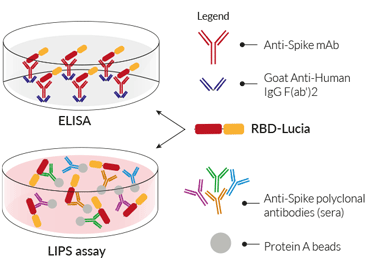
RBD-Lucia fusion protein for ELISA & LIPS
RBD-Lucia in ELISA
RBD-Lucia proteins can be used in a luciferase-based ELISA. Unlike a conventional ELISA, the plate is coated overnight with an Anti-human IgG F(ab')2 fragment. Upon addition of anti-spike monoclonal antibodies (mAb), they will bind to this 'capture' fragment through their Fc region, and RBD-Lucia will bind to the variable region. The luciferase activity is then used to assess the mAb binding affinity to the Spike RBD.
RBD-Lucia in LIPS
Currently, to perform a LIPS assay, soluble crude cell lysates or culture media of the luciferase tagged recombinant protein are extracted from transfected cells and directly used for the assay. InvivoGen's RBD-Lucia proteins streamline the protocol even further. Simply add the RBD-Lucia protein to either anti-spike mAbs or to anti‑spike polyclonal antibodies in the sera of recovered COVID‑19 patients and/or a vaccinee. Following this, antibody-protein complexes are purified using Protein A beads. Quantification of either binding affinity (mAb) and/or antibody levels (sera) is easily determined by assessing the Lucia luciferase activity.
Back to the top





